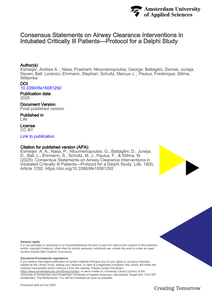Intubated critically ill patients are susceptible to secretion accumulation because of compromised airway clearance. Various airway clearance interventions are employed to prevent complications arising from mucus retention. This Delphi study aims to collect global opinions in an international expert panel of ICU professionals on the usefulness of these various airway clearance interventions. A steering committee performed a literature search informing the formulation of statements. Statements are grouped into two distinct parts: (1) Humidification and Nebulization, and (2) Suctioning and Mucus mobilization techniques. For each part, a diverse panel of 30–40 experts will be selected, with concerted effort to involve experts from various medical specialties involved in airway clearance methods. Multiple choice questions (MCQs) or 7-point Likert-scale statements will be used in the iterative Delphi rounds to reach consensus on various airway clearance interventions. Rounds will continue until stability is achieved for all statements. Consensus will be deemed achieved when a choice in MCQs or a Likert-scale statement achieves ≥75% agreement or disagreement. Starting from the second round of the Delphi process, stability will be assessed using non-parametric χ2 tests or Kruskal–Wallis tests. Stability will be defined by a p-value of ≥0.05.
DOCUMENT

Introduction. Despite the high number of inactive patients with COPD, not all inactive patients are referred to physical therapy, unlike recommendations of general practitioner (GP) guidelines. It is likely that GPs take other factors into account, determining a subpopulation that is treated by a physical therapist (PT). The aim of this study is to explore the phenotypic differences between inactive patients treated in GP practice and inactive patients treated in GP practice combined with PT. Additionally this study provides an overview of the phenotype of patients with COPD in PT practice. Methods. In a cross-sectional study, COPD patient characteristics were extracted from questionnaires. Differences regarding perceived health status, degree of airway obstruction, exacerbation frequency, and comorbidity were studied in a subgroup of 290 inactive patients and in all 438 patients. Results. Patients treated in GP practice combined with PT reported higher degree of airway obstruction,more exacerbations, more vascular comorbidity, and lower health status compared to patients who were not referred to and treated by a PT. Conclusion. Unequalpatient phenotypes in different primary care settings have important clinical implications. It can be carefully concluded that other factors, besides the level of inactivity, play a role in referral to PT.
DOCUMENT

INTRODUCTION: Mechanical Insufflation-Exsufflation (MI-E) is used as an airway clearance intervention in primary care (home ventilation), long-term care (prolonged rehabilitation after intensive care, neuromuscular diseases, and spinal cord injury), and increasingly in acute care in intensive care units (ICU).AIM: We sought to develop in-depth understanding of factors influencing decision-making processes of health care professionals regarding initiation, escalation, de-escalation, and discontinuation of MI-E for invasively ventilated patients including perceived barriers and facilitators to use.METHODS: We conducted focus groups (3 in the Netherlands; 1 with participants from four European countries) with clinicians representing the ICU interprofessional team and with variable experience of MI-E. The semi-structured interview guide was informed by the Theoretical Domains Framework (TDF). Two researchers independently coded data for directed content analysis using codes developed from the TDF.RESULTS: A purposive sample of 35 health care professionals participated. Experience varied from infrequent to several years of frequent MI-E use in different patient populations. We identified four main themes: (1) knowledge; (2) beliefs; (3) clinical decision-making; and (4) future adoption.CONCLUSION: Interprofessional knowledge and expertise of MI-E in invasively ventilated patients is limited due to minimal available evidence and adoption. Participants believed MI-E a potentially useful intervention for airway clearance and inclusion in weaning protocols when more evidence is available.RELEVANCE TO CLINICAL PRACTICE: This focus group study provides an overview of current practice, knowledge and expertise, and barriers and facilitators to using MI-E in mechanically ventilated patients. From these data, it is evident there is a need to develop further clinical expertise and evidence of efficacy to further understand the role of MI-E as an airway clearance technique for ventilated patients.
DOCUMENT
